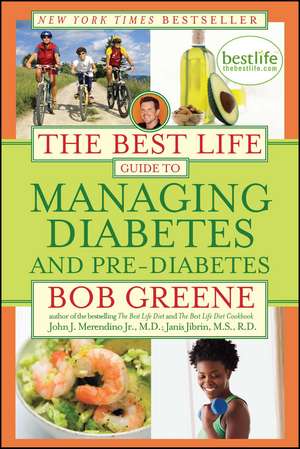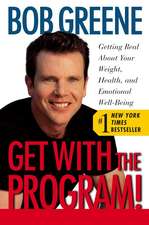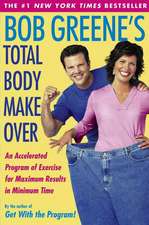The Best Life Guide to Managing Diabetes and Pre-Diabetes
Autor Bob Greene, John J. Merendino Jr., M.D., Janis Jibrin, M.S., R.D.en Limba Engleză Paperback – 20 ian 2011
Managing the many lifestyle changes that come with a diabetes diagnosis can seem overwhelming, but with Bob's approachable strategies and clear explanations, they will start to feel like second nature.
Preț: 102.85 lei
Nou
Puncte Express: 154
Preț estimativ în valută:
19.68€ • 20.47$ • 16.25£
19.68€ • 20.47$ • 16.25£
Carte disponibilă
Livrare economică 22 martie-05 aprilie
Preluare comenzi: 021 569.72.76
Specificații
ISBN-13: 9781416588399
ISBN-10: 1416588396
Pagini: 384
Dimensiuni: 140 x 210 x 23 mm
Greutate: 0.28 kg
Editura: Simon&Schuster
Colecția Simon & Schuster
ISBN-10: 1416588396
Pagini: 384
Dimensiuni: 140 x 210 x 23 mm
Greutate: 0.28 kg
Editura: Simon&Schuster
Colecția Simon & Schuster
Notă biografică
Bob Greene is an exercise physiologist and certified personal trainer specializing in fitness, metabolism, and weight loss. He holds a master’s degree from the University of Arizona and is a member of the American College of Sports Medicine and the American Council on Exercise. For the past seventeen years, he has worked with clients and consulted on the design and management of fitness, spa, and sports medicine programs. Bob has been a guest on the Oprah Winfrey Show. He is also a contributing writer and editor for O, The Oprah Magazine, and writes articles on health and fitness for Oprah.com. Greene is the bestselling author of The Best Life Diet Cookbook; The Best Life Diet, Revised and Updated; The Best Life Diet; The Best Life Diet Daily Journal; The Total Body Makeover; Get With the Program!; The Get With the Program! Daily Journal; The Get With the Program! Guide to Good Eating; and Make the Connection.
Janis Jibrin, M.S., R.D., is the lead nutritionist for thebestlife.com, Bob Greene’s weight loss and fitness website. She is also a contributing editor for Self magazine, the author of The Supermarket Diet and other weight loss books, and freelances for other national magazines. In her private practice, she specializes in weight loss and eating disorders.
Janis Jibrin, M.S., R.D., is the lead nutritionist for thebestlife.com, Bob Greene’s weight loss and fitness website. She is also a contributing editor for Self magazine, the author of The Supermarket Diet and other weight loss books, and freelances for other national magazines. In her private practice, she specializes in weight loss and eating disorders.
Extras
The Best Life Guide to Managing Diabetes and Pre-Diabetes
WHEN YOU FIRST FOUND out that you had diabetes or pre-diabetes, you probably experienced a wave of emotions: concern, fear, confusion, maybe even anger. But despite the fact that both are serious conditions, the good news is that there’s a lot you can do to stay healthy and improve your quality of life; there are so many more treatment options and resources at your disposal than just fifteen years ago. This is, in large part, a reaction to the epidemic in this country—about 24 million Americans have been diagnosed with diabetes and another 57 million have pre-diabetes, a precursor of the disease. Though this may not be positive news for us as a country, it’s placed diabetes high on the national health agenda. There are millions of people with these conditions, just like you, who are able to continue living a healthy and fulfilled life.
Always keep in mind that how well you fare after your diagnosis is largely up to you. Diabetes and pre-diabetes are conditions that you can manage well by making some important lifestyle changes. When you take the reins and do what you can to manage these conditions, you can dramatically improve your life. I’ve seen this firsthand—in family members who have diabetes as well as clients I’ve worked with over the years. The Best Life Guide to Managing Diabetes and Pre-Diabetes will map out a clear and practical plan for living your healthiest, happiest, fullest life. Once you know what diabetes and pre-diabetes are, how they affect you, and what you can do to stay healthy, you’ll feel more in control and less afraid.
The Best Life program’s design reflects the three pillars of diabetes management: diet, exercise, and medication. It’s no accident that I’ve listed medication last—diet and exercise are the drivers here. Eat right and move enough, and you won’t need as many drugs. In some cases, you can eliminate the drugs altogether, at least for a few years (diabetes is a progressive disease, so the need for medication usually arises again eventually). If you have pre-diabetes you’re probably not on medication; the Best Life program can completely reverse this condition and prevent diabetes down the road.
Whether you have pre-diabetes or diabetes, the dietary and fitness guidelines in this book will help you bring your blood sugar into the best possible range, with a minimum of highs and lows. If you have diabetes you’ll be using a blood glucose monitor to test your sugar and you’ll be logging (see log on page 335) select blood sugar readings, meals, and bouts of exercise. This log will play a crucial role in your diabetes management—it will help you piece together important patterns that you can use to create an individualized program that fits with your disease and your lifestyle. The response to food and exercise varies from person to person; the log will uncover your unique reactions. For instance, you might note that your blood sugar is usually high after eating bread but not after eating pasta. Or that your blood sugar is in a great range after 30 minutes on the treadmill but a little too low after 40 minutes. Or that the dose of medication taken in the morning seems to send your blood sugar plummeting in the afternoon, which is something you and your doctor can adjust.
Not only will all of these tools help you manage the disease—and in some cases, eliminate it altogether—they will also reduce your risk of some of the serious complications of diabetes, such as heart disease, stroke, eye disease, kidney disease, nerve damage, and sexual problems. If you already have one or more of these complications, following this plan can slow their progression and potentially even reverse them. And you’ll probably find that once you adopt this way of eating and exercising, you’ll be slimmer and healthier than you’ve ever been before.
It doesn’t matter how long you’ve had diabetes or pre-diabetes or how healthy you are right now. This plan works as well for someone who has just been diagnosed as it does for someone who has had diabetes for years and has a number of complications. This is as true of someone who’s sedentary and overweight as of someone who’s out running marathons. No matter how progressed your disease is or what your current health status is, this plan can be tailored to fit your needs and even your tastes. For instance, the diet plan, which is very flexible in terms of calories and types of meals, allows for easy substitutions. Hate broccoli but love zucchini? No problem! And the exercise plan meets you at your current level and helps you move up gradually, with useful, practical tips for increasing your activity at any level, from couch potato to ultimate athlete.
By taking the time to read and understand this book, you’ve already made a huge step toward living a healthier life, and I’m thrilled to guide you on this journey. For nearly three decades, I’ve been focused on helping people make meaningful changes in their lives, including being more active, overhauling their diet, losing weight, and discovering the issues that may be standing in the way of their happiness and well-being. Often the people who seek my help have a variety of ailments, including heart disease, arthritis, high blood pressure, and depression, but I’m seeing more and more people with pre-diabetes and diabetes. And because of their specific needs, I’ve partnered with two leading experts in their respective fields, John J. “Jack” Merendino Jr., M.D., and Janis Jibrin, M.S., R.D., to create a program that provides a multifaceted approach to managing the disease. As an exercise physiologist, I’ll help you safely step up your physical activity. Dr. Merendino will explain the specifics of diabetes and pre-diabetes care. A Yale- and Harvard-trained physician, he was a researcher at the National Institutes of Health before becoming a prominent endocrinologist, and has been caring for people with diabetes and pre-diabetes for more than twenty years. Janis offers a nutrition prescription that is loaded with delicious and tasty foods. She has authored several books and hundreds of magazine articles on healthy eating. She has been the lead nutritionist of www.thebestlife.com for the last few years, and I’ve witnessed her passion for nutrition and the joy she gets from helping people.
Before you get ready to jump in and get started, I want to prepare you: you definitely have to commit to this plan for it to work. If you rise to the challenge, you’ll be rewarded greatly, not only with good control of your diabetes or the reversal of your pre-diabetes, but also with more energy, a trimmer, fitter body, and better overall health. You can look at your diabetes or pre-diabetes diagnosis in one of two ways: as a strike against your health that’s too great to overcome, or as an opportunity to really care for and nurture yourself.
This program isn’t a quick fix. However, the gradual changes you’ll make during the three phases of the plan will ensure long-term success. During each phase, you’ll be given a number of goals to work on. After several weeks of practicing these healthy habits, you’ll be given another set of goals, and so on, until you’re leading a more active life, choosing more nutritious foods, and having consistently better control over your blood sugar. In my experience, the best way to change your diet and exercise habits is to do it gradually—it’s those changes that tend to stick for life. Here’s a quick snapshot of what the three phases look like:
![]() In Phase One, you’ll work on putting the appropriate amount of carbohydrates on your plate. You’ll be getting more exercise, using the Best Life Activity Scale as your guide. And all the while, you’ll be regularly checking your blood sugar if you have diabetes. (Need to lose weight? You should see the pounds start to drop in this phase.)
In Phase One, you’ll work on putting the appropriate amount of carbohydrates on your plate. You’ll be getting more exercise, using the Best Life Activity Scale as your guide. And all the while, you’ll be regularly checking your blood sugar if you have diabetes. (Need to lose weight? You should see the pounds start to drop in this phase.)
![]() Four weeks later, you’ll be ready to start Phase Two. At this point, you’ll work on tightening control of your blood sugar even further. You’ll be getting choosier about the carbs you eat; you’ll also get some guidance on the best protein-rich foods and healthful fats to eat at meals and snacks. You’ll use the Hunger Scale, a handy tool that will help you eat when you need to and stop when you should. And finally, many of you will add more physical activity. (Again, for those who need it, your weight should continue to drop.)
Four weeks later, you’ll be ready to start Phase Two. At this point, you’ll work on tightening control of your blood sugar even further. You’ll be getting choosier about the carbs you eat; you’ll also get some guidance on the best protein-rich foods and healthful fats to eat at meals and snacks. You’ll use the Hunger Scale, a handy tool that will help you eat when you need to and stop when you should. And finally, many of you will add more physical activity. (Again, for those who need it, your weight should continue to drop.)
![]() Phase Three is about staying healthy for life. Of course, you’ll still be keeping on top of your disease with all the lifestyle habits that have now become second nature, but in this phase you’ll set other aspects of good, lifelong care into place. For instance, you’ll be working on motivation and coping with the emotional side of your condition. You’ll refine your diet even further, not only to keep blood sugar in check, but to combat cancer and other chronic illnesses. You’ll become more confident at the doctor’s office when you read our advice on how to get the most out of your health care.
Phase Three is about staying healthy for life. Of course, you’ll still be keeping on top of your disease with all the lifestyle habits that have now become second nature, but in this phase you’ll set other aspects of good, lifelong care into place. For instance, you’ll be working on motivation and coping with the emotional side of your condition. You’ll refine your diet even further, not only to keep blood sugar in check, but to combat cancer and other chronic illnesses. You’ll become more confident at the doctor’s office when you read our advice on how to get the most out of your health care.
Throughout the three phases we’ll be filling you in on how medication (if you’re taking any) fits into the picture. For instance, we’ll explain how getting more exercise and eating fewer carbs might affect the dosage of your drugs. We’ve also devoted an entire chapter to medications, and this information will allow you to work with your doctor to make the best drug choices for you.
In addition to the information in this book, you can find ongoing support, more meals and recipes, and a handy online log at my Web site www.thebestlife.com. Dr. Merendino, Janis, and I, along with the team of Best Life nutritionists, exercise physiologists, and other health experts, have met with and exchanged e-mails with thousands of subscribers to the Web site; using their feedback and our knowledge, we’ve created a targeted diet plan for people with diabetes. As a member, you’ll get daily and weekly meal plans as well as an electronic Best Life Diabetes Management Log; you’ll also have access to other diabetes-related content to help you manage your condition better, as well as to a thriving community of people just like you who are trying to live more healthfully. You can share tips, offer encouragement, and get support whenever you need it.
I’m confident that the advice, facts, and guidance we offer in this book will put to rest the fears, confusion, and anxieties you first felt once you learned you had diabetes or pre-diabetes. And in time, I hope that you’ll be able to look back at your diagnosis as a turning point in your life—and a positive one at that, because it was the day you started making your health and your needs a priority. It was the day you made the conscious decision to start living your Best Life.
INTRODUCTION
WHEN YOU FIRST FOUND out that you had diabetes or pre-diabetes, you probably experienced a wave of emotions: concern, fear, confusion, maybe even anger. But despite the fact that both are serious conditions, the good news is that there’s a lot you can do to stay healthy and improve your quality of life; there are so many more treatment options and resources at your disposal than just fifteen years ago. This is, in large part, a reaction to the epidemic in this country—about 24 million Americans have been diagnosed with diabetes and another 57 million have pre-diabetes, a precursor of the disease. Though this may not be positive news for us as a country, it’s placed diabetes high on the national health agenda. There are millions of people with these conditions, just like you, who are able to continue living a healthy and fulfilled life.
Always keep in mind that how well you fare after your diagnosis is largely up to you. Diabetes and pre-diabetes are conditions that you can manage well by making some important lifestyle changes. When you take the reins and do what you can to manage these conditions, you can dramatically improve your life. I’ve seen this firsthand—in family members who have diabetes as well as clients I’ve worked with over the years. The Best Life Guide to Managing Diabetes and Pre-Diabetes will map out a clear and practical plan for living your healthiest, happiest, fullest life. Once you know what diabetes and pre-diabetes are, how they affect you, and what you can do to stay healthy, you’ll feel more in control and less afraid.
The Best Life program’s design reflects the three pillars of diabetes management: diet, exercise, and medication. It’s no accident that I’ve listed medication last—diet and exercise are the drivers here. Eat right and move enough, and you won’t need as many drugs. In some cases, you can eliminate the drugs altogether, at least for a few years (diabetes is a progressive disease, so the need for medication usually arises again eventually). If you have pre-diabetes you’re probably not on medication; the Best Life program can completely reverse this condition and prevent diabetes down the road.
Whether you have pre-diabetes or diabetes, the dietary and fitness guidelines in this book will help you bring your blood sugar into the best possible range, with a minimum of highs and lows. If you have diabetes you’ll be using a blood glucose monitor to test your sugar and you’ll be logging (see log on page 335) select blood sugar readings, meals, and bouts of exercise. This log will play a crucial role in your diabetes management—it will help you piece together important patterns that you can use to create an individualized program that fits with your disease and your lifestyle. The response to food and exercise varies from person to person; the log will uncover your unique reactions. For instance, you might note that your blood sugar is usually high after eating bread but not after eating pasta. Or that your blood sugar is in a great range after 30 minutes on the treadmill but a little too low after 40 minutes. Or that the dose of medication taken in the morning seems to send your blood sugar plummeting in the afternoon, which is something you and your doctor can adjust.
Not only will all of these tools help you manage the disease—and in some cases, eliminate it altogether—they will also reduce your risk of some of the serious complications of diabetes, such as heart disease, stroke, eye disease, kidney disease, nerve damage, and sexual problems. If you already have one or more of these complications, following this plan can slow their progression and potentially even reverse them. And you’ll probably find that once you adopt this way of eating and exercising, you’ll be slimmer and healthier than you’ve ever been before.
It doesn’t matter how long you’ve had diabetes or pre-diabetes or how healthy you are right now. This plan works as well for someone who has just been diagnosed as it does for someone who has had diabetes for years and has a number of complications. This is as true of someone who’s sedentary and overweight as of someone who’s out running marathons. No matter how progressed your disease is or what your current health status is, this plan can be tailored to fit your needs and even your tastes. For instance, the diet plan, which is very flexible in terms of calories and types of meals, allows for easy substitutions. Hate broccoli but love zucchini? No problem! And the exercise plan meets you at your current level and helps you move up gradually, with useful, practical tips for increasing your activity at any level, from couch potato to ultimate athlete.
By taking the time to read and understand this book, you’ve already made a huge step toward living a healthier life, and I’m thrilled to guide you on this journey. For nearly three decades, I’ve been focused on helping people make meaningful changes in their lives, including being more active, overhauling their diet, losing weight, and discovering the issues that may be standing in the way of their happiness and well-being. Often the people who seek my help have a variety of ailments, including heart disease, arthritis, high blood pressure, and depression, but I’m seeing more and more people with pre-diabetes and diabetes. And because of their specific needs, I’ve partnered with two leading experts in their respective fields, John J. “Jack” Merendino Jr., M.D., and Janis Jibrin, M.S., R.D., to create a program that provides a multifaceted approach to managing the disease. As an exercise physiologist, I’ll help you safely step up your physical activity. Dr. Merendino will explain the specifics of diabetes and pre-diabetes care. A Yale- and Harvard-trained physician, he was a researcher at the National Institutes of Health before becoming a prominent endocrinologist, and has been caring for people with diabetes and pre-diabetes for more than twenty years. Janis offers a nutrition prescription that is loaded with delicious and tasty foods. She has authored several books and hundreds of magazine articles on healthy eating. She has been the lead nutritionist of www.thebestlife.com for the last few years, and I’ve witnessed her passion for nutrition and the joy she gets from helping people.
Before you get ready to jump in and get started, I want to prepare you: you definitely have to commit to this plan for it to work. If you rise to the challenge, you’ll be rewarded greatly, not only with good control of your diabetes or the reversal of your pre-diabetes, but also with more energy, a trimmer, fitter body, and better overall health. You can look at your diabetes or pre-diabetes diagnosis in one of two ways: as a strike against your health that’s too great to overcome, or as an opportunity to really care for and nurture yourself.
This program isn’t a quick fix. However, the gradual changes you’ll make during the three phases of the plan will ensure long-term success. During each phase, you’ll be given a number of goals to work on. After several weeks of practicing these healthy habits, you’ll be given another set of goals, and so on, until you’re leading a more active life, choosing more nutritious foods, and having consistently better control over your blood sugar. In my experience, the best way to change your diet and exercise habits is to do it gradually—it’s those changes that tend to stick for life. Here’s a quick snapshot of what the three phases look like:
Throughout the three phases we’ll be filling you in on how medication (if you’re taking any) fits into the picture. For instance, we’ll explain how getting more exercise and eating fewer carbs might affect the dosage of your drugs. We’ve also devoted an entire chapter to medications, and this information will allow you to work with your doctor to make the best drug choices for you.
In addition to the information in this book, you can find ongoing support, more meals and recipes, and a handy online log at my Web site www.thebestlife.com. Dr. Merendino, Janis, and I, along with the team of Best Life nutritionists, exercise physiologists, and other health experts, have met with and exchanged e-mails with thousands of subscribers to the Web site; using their feedback and our knowledge, we’ve created a targeted diet plan for people with diabetes. As a member, you’ll get daily and weekly meal plans as well as an electronic Best Life Diabetes Management Log; you’ll also have access to other diabetes-related content to help you manage your condition better, as well as to a thriving community of people just like you who are trying to live more healthfully. You can share tips, offer encouragement, and get support whenever you need it.
I’m confident that the advice, facts, and guidance we offer in this book will put to rest the fears, confusion, and anxieties you first felt once you learned you had diabetes or pre-diabetes. And in time, I hope that you’ll be able to look back at your diagnosis as a turning point in your life—and a positive one at that, because it was the day you started making your health and your needs a priority. It was the day you made the conscious decision to start living your Best Life.
Descriere
The essential reference book for over 2 million UK sufferers.


















